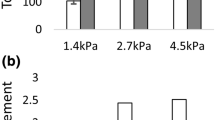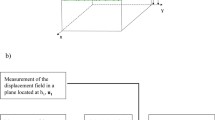Abstract
Quantitative measurements of cell-generated forces have heretofore required that cells be cultured on two-dimensional substrates. We describe a technique to quantitatively measure three-dimensional traction forces exerted by cells fully encapsulated in well-defined elastic hydrogel matrices. Using this approach we measured traction forces for several cell types in various contexts and revealed patterns of force generation attributable to morphologically distinct regions of cells as they extend into the surrounding matrix.



Similar content being viewed by others
References
Dembo, M. & Wang, Y.L. Biophys. J. 76, 2307–2316 (1999).
Keller, R., Davidson, L.A. & Shook, D.R. Differentiation 71, 171–205 (2003).
Huang, S., Chen, C.S. & Ingber, D.E. Mol. Biol. Cell 9, 3179–3193 (1998).
McBeath, R., Pirone, D.M., Nelson, C.M., Bhadriraju, K. & Chen, C.S. Dev. Cell 6, 483–495 (2004).
Balaban, N.Q. et al. Nat. Cell Biol. 3, 466–472 (2001).
Butler, J.P., Tolic-Norrelykke, I.M., Fabry, B. & Fredberg, J.J. Am. J. Physiol. Cell Physiol. 282, C595–C605 (2002).
Tan, J.L. et al. Proc. Natl. Acad. Sci. USA 100, 1484–1489 (2003).
Cukierman, E., Pankov, R., Stevens, D.R. & Yamada, K.M. Science 294, 1708–1712 (2001).
Pampaloni, F., Reynaud, E.G. & Stelzer, E.H. Nat. Rev. Mol. Cell Biol. 8, 839–845 (2007).
Miller, J.S. et al. Biomaterials 31, 3736–3743 (2010).
Paszek, M.J. et al. Cancer Cell 8, 241–254 (2005).
Discher, D.E., Janmey, P. & Wang, Y.L. Science 310, 1139–1143 (2005).
Chan, C.E. & Odde, D.J. Science 322, 1687–1691 (2008).
Maskarinec, S.A., Franck, C., Tirrell, D.A. & Ravichandran, G. Proc. Natl. Acad. Sci. USA 106, 22108–22113 (2009).
Hur, S.S., Zhao, Y., Li, Y.S., Botvinick, E. & Chien, S. Cell. Mol Bioeng. 2, 425–436 (2009).
Lutolf, M.P. & Hubbell, J.A. Nat. Biotechnol. 23, 47–55 (2005).
Elbert, D.L. & Hubbell, J.A. Biomacromolecules 2, 430–441 (2001).
Raeber, G.P., Lutolf, M.P. & Hubbell, J.A. Biophys. J. 89, 1374–1388 (2005).
Gao, L., McBeath, R. & Chen, C.S. Stem Cells 28, 564–572 (2010).
Acknowledgements
We thank J. Baranski, H. Hu, C. Shen and M. Wozniak for helpful discussions. This work was supported in part by grants from the US National Institutes of Health (EB00262, EB08396, GM74048, HL73305 and HL90747), the Resbio Technology Resource for Polymeric Biomaterials, the Material Research Science and Engineering Center and Center for Engineering Cells and Regeneration at the University of Pennsylvania, the National Science Foundation graduate research fellowship (W.R.L. and B.L.B.), the US National Institutes of Health T32 training grant and the Hartwell Foundation (J.S.M.).
Author information
Authors and Affiliations
Contributions
W.R.L., G.M.G. and C.S.C. conceived and initiated the project. W.R.L., J.S.M., B.L.B. and D.M.C. designed and performed experiments. C.S.C. supervised the project.
Corresponding author
Ethics declarations
Competing interests
The authors declare no competing financial interests.
Supplementary information
Supplementary Text and Figures
Supplementary Figures 1–10, Supplementary Notes 1–3 (PDF 3523 kb)
Supplementary Movie 1
Volume rendering of encapsulated cell and surrounding beads. An EGFP-expressing fibroblast (green) was encapsulated within a PEGDA hydrogel containing fluorescent beads (red). After spreading into the surrounding hydrogel, the cell was imaged using confocal microscopy. For clarity, the cell was rendered in front of the beads and only one half of all beads were rendered. (MOV 9907 kb)
Supplementary Movie 2
A 3D wall-eyed stereogram of bead displacements. Volume rendering showing the discretized surface mesh of the cell and tracked bead displacements, color-coded by magnitude, obtained from bead locations before and after cell lysis. (MOV 9641 kb)
Supplementary Movie 3
Cell lysis and hydrogel relaxation. A 2D confocal section showing an EGFP-expressing fibroblast and surrounding fluorescent beads during cell lysis with SDS. (MOV 4272 kb)
Supplementary Movie 4
A 3D wall-eyed stereogram rendering of cellular tractions. Tractions are color-coded by magnitude. For clarity, the surface mesh was made transparent to permit visualization of traction vectors directed inward from the cell surface. (MOV 8125 kb)
Rights and permissions
About this article
Cite this article
Legant, W., Miller, J., Blakely, B. et al. Measurement of mechanical tractions exerted by cells in three-dimensional matrices. Nat Methods 7, 969–971 (2010). https://doi.org/10.1038/nmeth.1531
Received:
Accepted:
Published:
Issue Date:
DOI: https://doi.org/10.1038/nmeth.1531
- Springer Nature America, Inc.
This article is cited by
-
Microinterfaces in biopolymer-based bicontinuous hydrogels guide rapid 3D cell migration
Nature Communications (2024)
-
Field Guide to Traction Force Microscopy
Cellular and Molecular Bioengineering (2024)
-
Cell–extracellular matrix mechanotransduction in 3D
Nature Reviews Molecular Cell Biology (2023)
-
Analysis of the compressible, isotropic, neo-Hookean hyperelastic model
Meccanica (2023)
-
Light-driven single-cell rotational adhesion frequency assay
eLight (2022)





